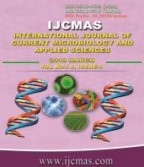


 National Academy of Agricultural Sciences (NAAS)
National Academy of Agricultural Sciences (NAAS)

|
PRINT ISSN : 2319-7692
Online ISSN : 2319-7706 Issues : 12 per year Publisher : Excellent Publishers Email : editorijcmas@gmail.com / submit@ijcmas.com Editor-in-chief: Dr.M.Prakash Index Copernicus ICV 2018: 95.39 NAAS RATING 2020: 5.38 |
Agricultural practices and technological changes for agricultural production may allow 30-50% of land use for Afforestation that leads to the increased terrestrial stock of carbon. Carbon sequestration in forest soils decreases CO2 in the atmosphere and projected climate variability. CO2 fertilization effect and rise in temperature may affect plant growth and net primary productivity (NPP) by increasing soil respiration and increasing available nitrogen by mineralization. Global scenarios that need extra land to produce food, feed, and biomass energy generation result in low carbon storage. Building soil organic carbon (SOC) by multipurpose crops, woody perrenials, cover crops, effective crop rotations, minimum tillage and crop residue management is critical for supporting biological processes, nutrient availability and hydrological cycle. The conservation and precision agriculture saves fertilizer inputs, land, and water resources and reduces the emission of greenhouse gases (GHG). Agro-biodiversity offers a choice of diverse crops and ecosystem services, and options of different varieties reduce the risk of crop failure at farmers’ fields. Crop species diversity and genetic diversity within species makes stable and productive agroecosystem that is less likely to harm by the variability of climatic factors, i.e., temperature, moisture, and photoperiod. C3 and C4 plants are grown at different times/seasons of the year and have different nitrogen requirement and root architecture (symbiont and non-symbiont). A legume provides biological nitrogen fixation, but phosphorous and potassium input would be required for maximization of yield potential. Diverse cropping systems conserve biodiversity, soil (SOC), water quality, and reduce fertilizer use thereby cut GHG emission. Family farmers have the knowledge of ecological and community requirements, past failure and consequences, therefore, their involvement in the technology-based agriculture help in finding realistic solutions for sustainable resource management.
 |
 |
 |
 |
 |